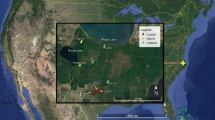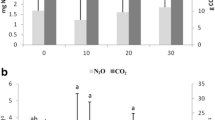Abstract
A static chamber technique was used weekly from spring thaw to winter freezing to measure methane emissions from 10 sites representing subarctic fens and temperate swamps and bogs. Rates of < 200 mg CH4 m−2 d−1 were recorded in subarctic fens: within-site emissions were primarily controlled by the evolution of the peat thermal regime, though significant releases during spring thaw were recorded at some sites. Between subarctic fens, topography and water table elevation were important controls on methane emissions, with the general sequence: pool = horizontal fen> string. Emission rates from the 2 swamp sites were lower (< 20 mg CH4 m−2 d−1 ), except during the spring thaw and when the sites were saturated. The low water table ( < 80 cm depth) in abnormally dry years reduced emission rates; rates were also low from a swamp site which had been drained and cleared of vegetation for horticulture. Methane emission rates were also low (< 5 mg CH4 m−2 d−1) from 2 ombrotrophic bog sites. Laboratory measurements of rates of methane production under anaerobic conditions and methane consumption under aerobic conditions revealed that production rates were generally highest in the surface layers (0 to 2.5 cm depth); production was high in the fens and very low in the bogs. The swamp samples were able to produce methane under anaerobic conditions, but were also able to consume methane under aerobic conditions. Annual methane emission rates are estimated to be 1 to 10 g CH4 m−2 from the fens, 1 to 4 g CH4 m−2 from the swamps and <0.2 g CH4 m−2 from the bogs and drained swamp.
Similar content being viewed by others
References
Aselmann I & Crutzen PJ (1989) Global distribution of natural freshwater wetlands and rice paddies, their net primary productivity, seasonality and possible methane emissions. J Atmos. Chem. 8: 307–359
Baker-Blocker A, Donahue TM & Mancy KH (1977) Methane flux from wetland areas. Tellus 29: 245–250
Barber TR, Burke RA Jr & Sackett WA (1988) Diffusive flux of methane from warm wetlands. Global Biogeochem. Cycles 2: 411–425
Bartlett KB, Crill PM, Sebacher DI, Harriss RC, Wilson JO & Melack JM (1988) Methane flux from the central Amazonian floodplain. J. Geophys. Res. 93: 1571–1582
Bartsch I & Moore TR (1985) A preliminary investigation of primary production and decomposition in four peatlands near Schefferville, Quebec. Can. J. Botany 63: 1241–1248
Canadian Soil Survey Committee, Subcommittee on Soil Classification (1978) The Canadian System of Soil Classification Canadian Department of Agriculture, Publication 1646, Supply and Services Canada, Ottawa
Cicerone RJ & Oremland RS (1988) Biogeochemical aspects of atmospheric methane. Global Biogeochem. Cycles 2: 299–327
Clymo RS & Reddaway (1971) A tentative dry matter balance sheet for the wet blanket bog on Burnt Hill, Moor House NNR. Aspects of the Ecology of the Northern Pennines. Moor House Occasional Paper No. 3, Nature Conservancy Council, London
Crill PM, Bartlett KB, Harriss RC, Gorham E, Verry ES, Sebacher DI, Madzar L & Sanner W (1988) Methane flux from Minnesota peatlands. Global Biogeochem Cycles 2: 371–384
Devol AH, Richey JE, Clark WA, King SL & Martinez LA (1988) Methane emissions to the troposphere from the Amazon floodplain. J. Geophys. Res. 93: 1583–1592
Foster DR, King GA, Glaser PH & Wright HE Jr (1983) Origin of string patterns in boreal peatlands. Nature 306: 256–258
Harriss RC & Sebacher DI (1981) Methane flux in forested freshwater swamps of the southeastern United States. Geophys. Res. Lett. 8: 1002–1004
Harriss RC, Sebacher DI & Day FF Jr (1982) Methane flux from the Great Dismal Swamp. Nature 297: 673–674
Harriss RC, Gorham E, Sebacher DI, Bartlett KB & Flebbe PA (1985) Methane flux from northern peatlands. Nature 315: 652–654
Hobbie JE, Traaen T, Rublee P, Reed JP, Miller MC & Fenichel T (1980) Decomposers, bacteria and micro-benthos. In: Hobbie JE (Ed) Limnology of Tundra Ponds (pp 340–387). Dowden,Hutchinson and Ross, Stroudsburg, Penn
Matthews E & Fung I (1987) Methane emissions from natural wetlands: global distribution, area and environmental characteristics of sources. Global Biogeochem. Cycles 1: 61–86
Moore TR (1987) The thermal regime of peatlands in subarctic eastern Canada. Can. J. Earth Sci. 24: 1352–1359
Moore TR (1989a) Growth and net primary production of Sphagnum at five fen sites, subarctic eastern Canada. Can. J. Botany 67: 1203–1207
Moore TR (1989b) Plant production and decomposition and carbon efflux in a subarctic patterned fen. Arctic and Alpine Research 21: 156–162
Moore TR & Knowles R (1987) Methane and carbon dioxide evolution from subarctic fens. Can. J. Soil Sci. 67: 77–81
Moore TR & Knowles R (1989) The influence of water table levels on methane and carbon dioxide emissions from peatland soils. Can. J. Soil Sci. 69: 33–3
Moore TR & Roulet NT A comparison of static and dynamic chambers for methane emission measurements from subarctic fens (unpubl. ms.)
National Wetlands Working Group (1988) Wetlands of Canada. Ecological Land Classification Series, No. 24. Sustainable Development Branch, Environment Canada, Ottawa and Polyscience Publications, Montreal, 452 pp
Nelson LM & Knowles R (1978) Effect of oxygen and nitrate on nitrogen fixation and denitrification by Azospirillum brasilense grown in continuous culture. Can. J. Microbial. 24: 1395–1403
Ramanathan V (1988) The greenhouse theory of climatic change: a test by an inadvertant global experiment. Science 240: 293–299
Sebacher DI, Harriss RC & Bartlett KB (1983) Methane flux across the air-water interface: Air velocity effects. Tellus 35B: 103–109
Sebacher DI, Harriss RC, Bartlett KB, Sebacher SM & Grice SS (1986) Atmospheric methane sources: Alaskan tundra bogs, an alpine fen, and a subarctic boreal marsh. Tellus 36B: 1–10
Steele LP, Fraser JP, Rasmussen RA, Khalil MAK, Conway TJ, Crawford AJ, Gammon RH, Maserie KA & Thoning KW (1987) The global distribution of methane in the troposphere. J. Atmos. Chem. 5: 125–172
Svensson BH (1976) Methane production in tundra peat. In: Schlegel HG, Gottschalk G & Pfennig N (Eds) Microbial Production and Utilization of Gases (pp 135–139). Goltze KG, Gottingen, FRG
Svensson BH (1980) Carbon dioxide and methane fluxes from the ombrotrophic parts of a subarctic mire. Ecol. Bull. (Stockholm) 30: 235–250
Svensson BH (1983) Carbon fluxes from acid peat of a subarctic mire with emphasis on methane. Report 20, Department of Microbiology, Swedish University of Agricultural Sciences, Uppsala, Sweden
Svensson BH (1984) Different temperature optima for methane formation when enrichments are supplemented with acetate or hydrogen. Appl. Environ. Microbiol. 48: 389–394
Svensson BH & Rosswall T (1980) Energy flow through the subarctic mire at Stordalen. Ecol. Bull. (Stockholm) 30: 283–301
Svensson BH & Rosswall T (1984) In situ methane production from acid peat in plant communities with different moisture regimes in a subartic mire. Oikos 43: 341–350
Whalen SC & Reeburgh WS (1988) A methane flux time series for tundra environments. Global Biogeochem. Cycles 2: 399–409
Williams RT & Crawford RL (1984) Methane production in Minnesota peatlands. Appl. Environ. Microbiol. 47: 1266–1271
Williams RT & Crawford RL (1985) Methanogenic bacteria, including an acid-tolerant strain, from peatlands. Appl. Environ. Microbiol. 50: 1542–1544
Wilson JO, Crill PM, Bartlett KB, Sebacher DI, Harriss RC & Sass RL (1989) Seasonal variation of methane emissions from a temperate swamp. Biogeochemistry 7: 55–71
Yavitt JB, Lang GE & Wieder RK (1987) Control of carbon mineralization to CH4 and CO2 in anaerobic,Sphagnum-derived peat from Big Run Bog, West Virginia. Biogeochemistry 4: 141–157
Zoltai SC & Pollett FC (1983) Wetlands in Canada: their classification, distribution and use. In: Gore AJP (Ed) Mires: Swamp, Bog, Fen and Moor, B(pp245–268). Regional Studies. Elsevier, Amsterdam, The Netherlands




